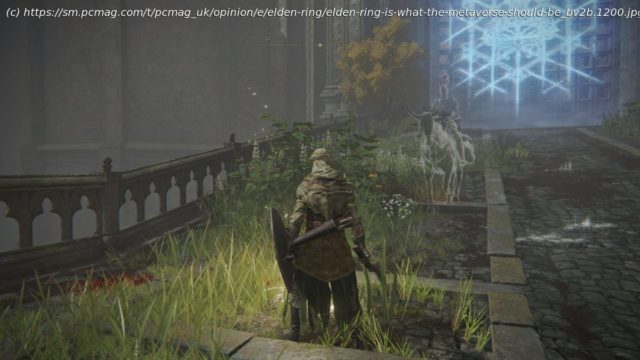Elden Ring’s asynchronous multiplayer features, combined with augmented reality, should be a model for those developing the metaverse.
Try as I might to avoid it, the metaverse has been on my mind a lot lately. Though it’s little more than a vague mishmash of already-common online concepts theoretically unified by virtual and augmented reality in some way, it’s getting the hard sell from marketers, PR reps, and tech bros. It’s also a part of Facebook’s cynical rebranding, but my focus has been drawn more to the non-Meta parts of the metaverse, particularly as I’ve been playing Elden Ring. With Elden Ring and Dark Souls, From Software may have unintentionally designed the ideal AR implementation of the metaverse. I’m not trolling, or making a wry joke about the games’ difficulty and violence. I’m talking about the low-key genius of From Software developing an asynchronous communications system in its games, which I think could be revolutionary outside of games. A helpful message in Elden Ring. From Software’s Multiplayer Pillars Elden Ring doesn’t have simple one-to-one cooperative or competitive modes. You can jump into other players’ games and they can jump into yours to fight or help with bosses, but only under very specific conditions. You also can’t directly talk to other players at any point. Despite these limitations, Elden Ring is absolutely saturated in communication between players, filtered and organized in brilliant ways. Elden Ring has three core multiplayer features: messages, ghosts, and summons. They each work differently and none have a significant effect on your gameplay, but together they make the game feel alive and populated, and let people help each other. Messages are written by using the Tarnished’s Wizened Finger, an item you get at the very beginning of the game (and which you should assign to a quick pouch slot so you can easily use it). When you do, you can write a message that appears as a glowing sign on the ground, and any player can read if they’re nearby. You can’t write just anything to other players, though. You have to choose from a collection of templates and a limited glossary, combining something like “**** ahead!” with “Trap” to leave the message “Trap ahead!” This means messages can’t be personal or directly toxic or threatening; they can only be helpful or playful. You can also pair the message with a gesture, which makes a ghost of your character perform a simple action in front of whoever reads the message. That guy getting killed hard by the troll who spawns right in front of me. The second multiplayer feature is ghosts. As you play, you’ll sometimes see white ghosts of other players also currently playing the game. The actions of these ghosts will be visible, but no context for those actions will be given; you won’t be able to see the enemy a player is fighting, only that they’re fighting something. These ghosts appear randomly, but you can also trigger a different kind of ghost that’s much more useful. Bloodstains will appear on the ground where players died, and you can interact with them to make a ghost appear showing that player’s last few moments. The enemies still won’t be visible, but you’ll be able to identify where an ambush might come from, where a trap might be, or simply if a fall is too high from watching that ghost. The third multiplayer feature is summons.






